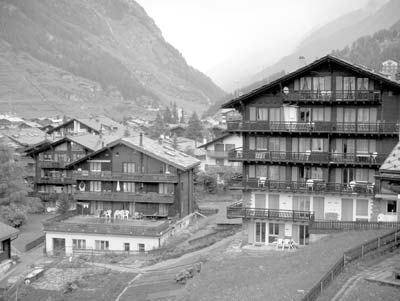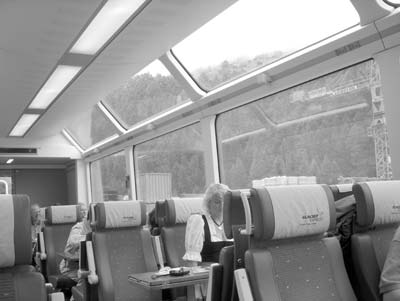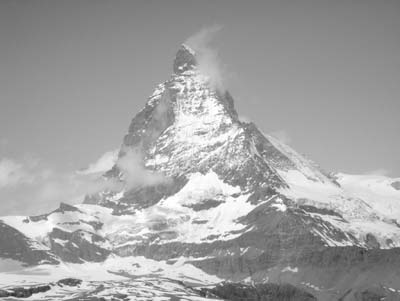New Premium Glacier Express
by Jay Brunhouse
Your new Premium Glacier Express train smartly bends within inches of sheer rock faces that Swiss laborers carefully hewed to allow its safe passage.
With the introduction in 2007 of new “Premium” panoramic carriages, Glacier Express, the most famous panoramic train in Europe and long an ITN readers’ favorite, increased the white-and-red train’s magnetism and pleasure in 2007.
St. Moritz (5,822 feet) and Zermatt (5,261 feet) surmount each end of your trip 169 miles across the top of the Alps, but along the way you climb to 6,668 feet at the summit, Oberalp Passhohe, cross 291 bridges and viaducts and pass through 91 tunnels.
In 2003, Stadler Alterhein, the Swiss system provider of customized rail vehicles, secured an order worth CHF47.3 million to provide 24 new carriages to form four trains that the Matterhorn-Gotthard Railroad, or MGB (www.mgbahn.ch), and Rhaetian Railroads, or RhB (www.rhb.ch), branded “Premium Glacier Express.”
Additional space
In first class, designers arranged red moquette seats two facing two on one side and a single seat facing the other on the opposite. In second class, all seats are two opposite two, but there is no loss of legroom because in both classes there are only six seating groups per side, placed beside wide panoramic windows that have been designed so that passengers never sit beside a window frame to obstruct their views. Smaller panes canted into the roof reveal spectacular views of the mountain peaks.
Earphones provide sightseeing pointers in your choice of six languages and acquaint you with the splendid natural wonders you pass. Station and travel information is shown on displays at the ends of the carriages.
Waitresses aboard the new premium trains from Zermatt on the nearly 8-hour trip to St. Moritz serve freshly cooked meals at passengers’ seats from the stainless-steel kitchen of the service car, while the still-sparkling first-generation panoramic Glacier Express trains to Chur (5½ hours) and Davos (six hours) add a belle époque Glacier Express dining carriage with white tablecloth service midway on their journey.
Thumping cogs
Shortly after your 9:08 a.m. departure from Zermatt’s train station, which is the heart of the city, you feel the thumping of cogwheels engaging. The waitress arrives, checks on meal reservations and arranges the fold-out dining tables for passengers who have ordered lunch. You pass cataracts, rushing waters and tall, wooden Valais houses and storage barns, or Spychers, protected from rats by stones.
The 3-course meal consists of asparagus soup, Zürich Geschnetzeltes (minced beef in a lovely cream sauce), carrots and rice. Tiramisu and a cheese selection follow. The cost? CHF38 ($31). You may choose the main dish without soup, dessert or cheese for CHF26 ($21). A complete à la carte menu, including vegetarian, is additionally available.
The cogs reengage at Randa, seven miles down the Glacier Express route, where you see the Dom rising up one side and the Weisshorn up the other. These are the highest peaks in the Alps after Mont Blanc and Monte Rosa.
Descending another eight miles, you pass through Brattbach Tunnel, 428 feet long, and a series of concrete avalanche shelters. Officials realized these were necessary to maintain Zermatt as a winter sports center when the winter avalanche of 1931-32 buried the line.
The junction at Brig is a good point to change between the narrow-gauge MGB to and from Zermatt and standard-gauge SBB trains to Lausanne or Cisalpino trains to and from Italy.
Across the Alps
You depart Brig through the scenic and broad upper Rhone Valley at 3,300 to 4,300 feet. The valley supports farms and farmhouses on both sides of the line. Dense pine forests clothe the lower slopes of the mountains. Above, you make out high Alpine pastures and still-higher summits covered with snow the year around.
Your train climbs steadily from Brig except for abrupt steps typical of glacial valleys. At these steps, the valleys also narrow, forcing your train to use loops, spirals or a rack, or even all three, to surmount the height.
After you pass through the chestnut forests surrounding the village of Morel, you reach Betten, where again you feel the cogwheels chattering as you climb. Past Grengiols, you cross the viaduct of the same name (102 feet high, the highest bridge of the MGB) and enter a tunnel looped to correct an altitude difference of 505 feet.
Leaving behind the Rhone Valley’s picturesque villages, you pass the reddish-brown Oberwald station (4,480 feet), where your train swings into the all-weather, 9.59-mile Furka Tunnel, the longest narrow-gauge train tunnel in the world, which permits the Glacier Express to operate year-round.
After 17 minutes you emerge from the tunnel at Realp (5,045 feet). From there you serpentine downward through six U-turns with a view down on Andermatt (4,701 feet), the famous ski resort.
At Andermatt’s depot and spacious, modern station you have the option of changing to MGB’s 2.3-mile-long, double-rack railroad that spectacularly descends the mountainside in 15 minutes to Göschenen, where you can board trains of the Gotthard Line between Zürich/Luzern and Lugano/Milano.
Top of the line
Continuing past Andermatt, you begin climbing sharply to the Oberalp Pass, the highest point on the line (6,670 feet), but you feel the cogwheels under the train chattering, so you know your climb is under total control. As you leave, Andermatt appears almost vertically below your train, first on one side and then on the other.
In nearly an hour you come to a stop in Disentis (3,707 feet) and enter the RhB network, where Eurail products are valid. Don’t look for inspiration in the eye-catching onion-shaped dome of the baroque church on the valley floor. Look up to the left (north) to the imposing Benedictine Abbey that is the place of prayer for the rich folks. The poorer folk attend the church on the valley floor. Disentis used to be divided into two villages: one by the abbey, one by the river.
Passing over the lofty Val Rusein and Val Lumpegna viaducts shortly out of Disentis, you descend steadily to Ilanz. For the first four miles you run high above the left bank of the Outer Rhine on a rock ledge. Approaching Ilanz, the lower slopes of the valley are thickly wooded with conifers. Past Ilanz, on the 1903 Ilanz Line, you see spectacular limestone scenery.
In Reichenau, where the Outer Rhine and the Inner Rhine converge next to the imposing railroad bridge, your Glacier Express meets the Albula Line to Chur, the capital of the canton of Graubünden.
Five hours and 49 minutes after you left Zermatt, your Glacier Express arrives in Chur’s award-winning 1994 train station with a 165-foot, fully glazed arched roof soaring over the high-level postal bus station. From Chur, three Glacier Expresses continue, one to Davos Platz Station and two to St. Moritz.
Please note
During winter, only one Glacier Express train operates daily. During summer, obligatory reservation fees and the supplement amount to CH30 ($23) in addition to the cost of your railpass or ticket. Eurail products are not honored by MGB. Purchase of a Swiss Pass is recommended. Meal reservations are best made in advance.
I thank Switzerland Tourism (877/794-8037, www.myswitzerland.com) for arrangements, including the Swiss Travel System’s (www.sbb.ch) Swiss Pass and Swiss International Airlines’ (www.swiss.com) flight from Los Angeles. I also thank Amadé Perrig, former director of Zermatt Tourism, for alerting me to this development.



